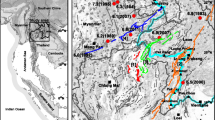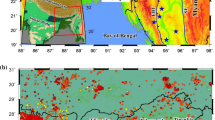Abstract
In order to examine the precursory seismic quiescence of upcoming hazardous earthquakes, the seismicity data available in the vicinity of the Thailand–Laos–Myanmar borders was analyzed using the Region–Time–Length (RTL) algorithm based statistical technique. The utilized earthquake data were obtained from the International Seismological Centre. Thereafter, the homogeneity and completeness of the catalogue were improved. After performing iterative tests with different values of the \(r_{0}\) and \(t_{0}\) parameters, those of \(r_{0}\) = 120 km and \(t_{0}\) = 2 yr yielded reasonable estimates of the anomalous RTL scores, in both temporal variation and spatial distribution, of a few years prior to five out of eight strong-to-major recognized earthquakes. Statistical evaluation of both the correlation coefficient and stochastic process for the RTL were checked and revealed that the RTL score obtained here excluded artificial or random phenomena. Therefore, the prospective earthquake sources mentioned here should be recognized and effective mitigation plans should be provided.






Similar content being viewed by others
References
Charusiri P, Daorerk V, Wongvanich T, Nakapadungrat S and Imsamut S 1999 Geology of the Quadrangle Economic Zone (emphasis on China and Thailand); Technical report, National Research Council of Thailand, Bangkok, Thailand, 189p (in Thai with English abstract).
Chen C and Wu Y 2006 An improved region–time–length algorithm applied to the 1999 Chi–Chi, Taiwan earthquake; Geophys. J. Int. 166 144–147.
Fenton C H, Charusiri P and Wood S H 2003 Recent paleoseismic investigations in northern and western Thailand; Ann. Geophys. 46(5) 957–981.
Gambino S, Laudani A and Mangiagli S 2014 Seismicity pattern changes before the M = 4.8 Aeolian Archipelago (Italy) earthquake of August 16, 2010; Sci. World J. 2014 1–8.
Gardner J K and Knopoff L 1974 Is the sequence of earthquakes in southern California, with aftershocks removed, Poissonian? Bull. Seismol. Soc. Am. 64(1) 363–367.
Gentili S 2010 Distribution of seismicity before the larger earthquakes in Italy in the time interval 1994–2004; Pure Appl. Geophys. 167 933–958.
Giovambattista R D and Tyupkin T 1999 Spatial and temporal distribution of seismicity before the Umbria–Marche September 26, 1997 earthquakes; J. Seismol. 4(4) 589–598.
Gutenberg B and Richter C F 1944 Frequency of earthquakes in California; Bull. Seismol. Soc. Am. 34 185–188.
Habermann R E 1983 Teleseismic detection in the Aleutian Island Arc; J. Geophys. Res. 88 5056–5064.
Habermann R E 1987 Man-made changes of seismicity rates; Bull. Seismol. Soc. Am. 77 141–159.
Holliday J R, Rundle J B, Tiampo K F, Klein W and Donnellan A 2006 Systematic procedural and sensitivity analysis of the pattern informatics method for forecasting large MN5 earthquake events in southern California; Pure Appl. Geophys., https://doi.org/10.1007/s00024-006-0131-1.
Huang Q 2004 Seismicity changes associated with the 2000 earthquake swarm in the Izu Island region; J. Asian Earth Sci. 26 509–517.
Huang Q 2005 A method of evaluating reliability of earthquake precursors; Chin. J. Geophys. 48(3) 701–707.
Huang Q and Sobolev G A 2002 Precursory seismicity changes associated with the Nemuro peninsula earthquake, January 28, 2000; J. Asian Earth Sci. 21(2) 135–146.
Huang Q, Sobolev G A and Nagao T 2001 Characteristics of the seismic quiescence and activation patterns before the M=7.2 Kobe earthquake, January 17, 1995; Tectonophys. 337(1–2) 99–116
Huang Q, Oncel A O and Sobolev G A 2002 Precursory seismicity changes associated with the Mw=7.4 1999 August 17 Izmit (Turkey) earthquake; Geophys. J. Int. 151(1) 235–242.
Iwakuni M, Kato T, Takiguchi H, Nakaegawa H and Satomura M 2004 Crustal deformation in Thailand and tectonics of Indochina peninsula as seen from GPS observations; Geophys. Res. Lett. 31 L11612, https://doi.org/10.1029/2004GL020347.
Jordan T H and Jones L M 2010 Operational earthquake forecasting: Some thoughts on why and how; Seis. Res. Lett. 81(4) 571–574.
Lacassin R A 1998 Replumaz and PH Leloup Hairpin river loops and strike-slip sense inversion of southeast Asian strike-slip faults; Geology 26 703–706.
Mignan A and Giovambattista R D 2008 Relationship between accelerating seismicity and quiescence, two precursors to large earthquakes; Geophys. Res. Lett. 35(15) L15306.
Morley C K 2007 Variations in Late Cenozoic–Recent strike-slip and oblique-extensional geometries, within Indochina: The influence of pre-existing fabrics; J. Struct. Geol. 29 36–58.
Nagao T, Takeuchi A and Nakamura K 2011 A new algorithm for the detection of seismic quiescence: Introduction of the RTM algorithm, a modified RTL algorithm; Earth Planets Space 63(3) 315–324.
Ornthammarath T, Muenhong K, Sukkadistand N and Innoi K 2015 Classification and analysis of damaged buildings in Dong Ma Da township following Mae Lao Earthquake on 5 May 2014; The 20th National Convention on Civil Engineering, 8–10 July 2015, Chonburi, Thailand, pp. 1–7.
Pailoplee S and Choowong M 2013 Probabilities of earthquake occurrences in Mainland Southeast Asia; Arab. J. Geosci. 6 4993–5006.
Pailoplee S and Choowong M 2014 Earthquake frequency–magnitude distribution and fractal dimension in Mainland Southeast Asia; Earth Planets Space 6(8) 1–10.
Pailoplee S, Sugiyama Y and Charusiri P 2009 Deterministic and probabilistic seismic hazard analyses in Thailand and adjacent areas using active fault data; Earth Planets Space 61 1313–1325.
Pailoplee S, Channarong P and Chutakositkanon V 2013 Earthquake activities in the Thailand–Laos–Myanmar Border region: A statistical approach; Terr. Atmos. Ocean Sci. 24(4) Part II 721–730.
Polachan S, Pradidtan S, Tongtaow C, Janmaha S, Intrawijitr K and Sangsuwan C 1991 Development of Cenozoic basins in Thailand; Mar. Petrol. Geol. 8 84–97.
Simons W J F, Socquet A, Vigny C, Ambrosius B A C, Abu S H, Promthong C, Subarya C, Sarsito D A, Matheussen S, Morgan P and Spakman W 2007 A decade of GPS in southeast Asia: Resolving Sundaland motion and boundaries; J. Geophys. Res. 112 B06420, https://doi.org/10.1029/2005JB003868.
Sobolev G A 1995 Fundamental of Earthquake Prediction; Electromagnetic Research Center, Moscow, 162p.
Sobolev G A and Tyupkin Y S 1997 Low-seismicity precursors of large earthquakes in Kamchatka; Volc. Seismol. 18 433–446.
Sobolev G A and Tyupkin Y S 1999 Precursory phases, seismicity precursors, and earthquake prediction in Kamchatka; Volc. Seismol. 20 615–627.
Tiampo K F and Shcherbakov R 2011 Seismicity-based earthquake forecasting techniques: Ten years of progress; Tectonophys. 522–523 89–121.
Wang Y, Lin Y-N N, Simons M and Tun S T 2014 Shallow rupture of the 2011 Tarlay earthquake (M\(_{{\rm w}}\) 6.8), eastern Myanmar; Bull. Seismol. Soc. Am. 104(6) 2904–2914.
Wells D L and Coppersmith K J 1994 Updated empirical relationships among magnitude, rupture length, rupture area, and surface displacement; Bull. Seismol. Soc. Am. 84 974–1002.
Wiemer S 2001 software package to analyze seismicity: ZMAP; Seismol. Res. 72 373–382.
Wiemer S and Wyss M 1994 Seismic quiescence before the Landers M=7.5 and Big Bear M=6.5 1992 earthquakes; Bull. Seismol. Soc. Am. 84 900–916.
Woessner J and Wiemer S 2005 Assessing the quality of earthquake catalogues: Estimating the magnitude of completeness and its uncertainty; Bull. Seismol. Soc. Am. 95(2) 684–698.
Wyss M 1991 Reporting history of the central Aleutians seismograph network and the quiescence preceding the 1986 Andreanof Island earthquake; Bull. Seismol. Soc. Am. 81 1231–1254.
Yadav R B S, Tripathi J N, Shanker D, Rastogi B K, Das M C and Kumar V 2011 Probabilities for the occurrences of medium to large earthquakes in northeast India and adjoining region; Nat. Hazards 56 145–167.
Zuchiewicz W, Cuong N Q, Bluszcz A and Michalik M 2004 Quaternary sediments in the Dien Bien Phu fault zone, NW Vietnam: A record of young tectonic processes in the light of OSL–SAR dating results; Geomorphology 60 269–302.
Zúñiga F R, Reyes M A and Valdés C 2000 A general overview of the catalog of recent seismicity compiled by the Mexican Seismological Survey; Geofís. Int. 39(2) 161–170.
Acknowledgements
This research was funded by the Ratchadapisek Sompoch Endowment Fund (2017), Chulalongkorn University (760003-CC). Thanks are also extended to T Pailoplee for the preparation of the draft manuscript. The authors thank the Office of Research Affairs, Chulalongkorn University, for a critical review and improved English. The authors acknowledge thoughtful comments and suggestions by the editors and anonymous reviewers that enhanced the quality of this manuscript significantly.
Author information
Authors and Affiliations
Corresponding author
Additional information
Corresponding editor: N V Chalapathi Rao.
Rights and permissions
About this article
Cite this article
Puangjaktha, P., Pailoplee, S. Application of the region–time–length algorithm to study of earthquake precursors in the Thailand–Laos–Myanmar borders. J Earth Syst Sci 127, 36 (2018). https://doi.org/10.1007/s12040-018-0939-y
Received:
Revised:
Accepted:
Published:
DOI: https://doi.org/10.1007/s12040-018-0939-y




